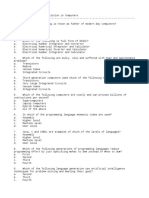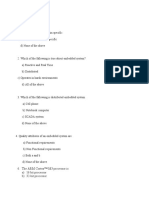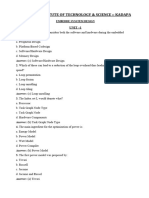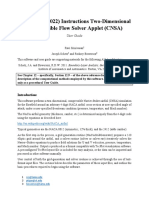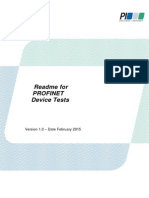Quiz Introduction To Robotics: Part 1 Overview
Quiz Introduction To Robotics: Part 1 Overview
Uploaded by
Ronin-AquaZCopyright:
Available Formats
Quiz Introduction To Robotics: Part 1 Overview
Quiz Introduction To Robotics: Part 1 Overview
Uploaded by
Ronin-AquaZOriginal Title
Copyright
Available Formats
Share this document
Did you find this document useful?
Is this content inappropriate?
Copyright:
Available Formats
Quiz Introduction To Robotics: Part 1 Overview
Quiz Introduction To Robotics: Part 1 Overview
Uploaded by
Ronin-AquaZCopyright:
Available Formats
QUIZ
Introduction to Robotics: Part 1 Overview
1. Who first introduced the word “robot”?
a. Isaac Asimov
b. Karel Capek
c. Isaac Newton
d. R2-D2
2. Where was the term “robotics” first used?
a. On the set of Star Trek
b. In a GM industrial plant
c. The Massachusetts Institute of Technology
d. In science fiction stories
3. What was the purpose of Asimov’s Laws of Robotics?
a. To insure that robots always serve mankind
b. To insure that robots become our masters
c. To insure that robots become sentient
d. To insure that the military never gains control of robots
4. Which of the following is NOT a fictional robot?
a. R2-D2
b. The Unimate
c. The Cyberdyne Systems Model 101 Terminator
d. Lieutenant Commander Data
5. What do industrial robots look like?
a. Humanoid with legs and arms
b. A small vacuum cleaner
c. A multi-jointed arm with a fixed base
d. A soft, furry pet
Copyright © Texas Education Agency, 2017. All rights reserved. 1 of 4
6. Which engineering field would specialize in an understanding of robotic motion?
a. Electrical Engineering
b. Mechanical Engineering
c. Industrial Engineering
d. Civil Engineering
7. Which engineering field would specialize in an understanding of manufacturing
processes?
a. Electrical Engineering
b. Mechanical Engineering
c. Industrial Engineering
d. Civil Engineering
8. Which engineering field would specialize in an understanding of robotic control
systems?
a. Electrical Engineering
b. Mechanical Engineering
c. Industrial Engineering
d. Civil Engineering
9. True or false: women are not suitable for jobs involving robotics.
10. Which of the following statements is true?
a. All robots are intelligent
b. All robots act like humans
c. All robots are controlled remotely
d. All robots are electromechanical machines using electronic programming
11. Which of the following systems uses motors and gears?
a. The structural system
b. The propulsion system
c. The sensor and feedback system
d. The control system
Copyright © Texas Education Agency, 2017. All rights reserved. 2 of 4
12. The microcontroller is part of which of the following systems?
a. The structural system
b. The propulsion system
c. The sensor and feedback system
d. The control system
13. Which of the following systems provide support and stability?
a. The structural system
b. The propulsion system
c. The sensor and feedback system
d. The control system
14. Which of the following systems use a transducer?
a. The structural system
b. The propulsion system
c. The sensor and feedback system
d. The control system
15. Where are tethered robots used most often?
a. In an industrial plant
b. In a student robot
c. In military applications
d. In automotive applications
16. Which of the following is the most common source of power for a student robot?
a. Alternating Current
b. Batteries
c. Pneumatics
d. Hydraulics
17. Which of the following does not need a power source to operate?
a. The propulsion system
b. The control system
c. The sensor and feedback system
d. The structural system
Copyright © Texas Education Agency, 2017. All rights reserved. 3 of 4
18. List three common robotic applications.
jobs that are:
1.
2.
3.
19. List three benefits of robot use in industry.
1.
2.
3.
20. Describe the types of jobs where robots replace human workers.
21. Describe the types of jobs created by industry use of robots.
22. Describe three features of a robot.
1.
2.
3.
23. Describe how robots have evolved.
Copyright © Texas Education Agency, 2017. All rights reserved. 4 of 4
You might also like
- Basic Robotics 1st Edition Dinwiddie Solutions Manual 1Document61 pagesBasic Robotics 1st Edition Dinwiddie Solutions Manual 1thomas100% (56)
- Robotics MCQDocument12 pagesRobotics MCQRahul Thorat71% (14)
- Telerik UI For Xamarin 2022 1 222 1Document2,537 pagesTelerik UI For Xamarin 2022 1 222 1Ricardo PadillaNo ratings yet
- Robotics - Automation-Question BankDocument10 pagesRobotics - Automation-Question BankMansi PatelNo ratings yet
- 1-Robot Is Derived From Czech WordDocument10 pages1-Robot Is Derived From Czech WordprabhaNo ratings yet
- Hre400 Relay Expansion Module: User ManualDocument6 pagesHre400 Relay Expansion Module: User Manualnhocti007No ratings yet
- Quiz Introduction To Robotics: Part 1 OverviewDocument4 pagesQuiz Introduction To Robotics: Part 1 OverviewRonin-AquaZNo ratings yet
- QUIZ Answer Key Introduction To Robotics: Part 1Document4 pagesQUIZ Answer Key Introduction To Robotics: Part 1Kristine Morada100% (1)
- IntroductiontoroboticsDocument5 pagesIntroductiontoroboticsapi-358875983No ratings yet
- Robo MCQDocument10 pagesRobo MCQShaikh SaadNo ratings yet
- Soal Uas Robotic 3 Ea 2023Document7 pagesSoal Uas Robotic 3 Ea 2023M Dwi RiskiNo ratings yet
- Robotics ProperDocument182 pagesRobotics PropermacxNo ratings yet
- RoboticsDocument41 pagesRoboticsMark Jason100% (3)
- ACFrOgCOK3eyg1J UWlU5cqkQl1eGVQ527MfFnATiIsjSswcfjJYK t1AgyIE4FDlxrpxWIaPIyESXdsU 6UAdPUNMzltSGntyUOyhpmrzf TiixyYCf4yF0Q3djfKMwv5SDTjNIXAm6cLcce0AdDocument9 pagesACFrOgCOK3eyg1J UWlU5cqkQl1eGVQ527MfFnATiIsjSswcfjJYK t1AgyIE4FDlxrpxWIaPIyESXdsU 6UAdPUNMzltSGntyUOyhpmrzf TiixyYCf4yF0Q3djfKMwv5SDTjNIXAm6cLcce0AdrijuNo ratings yet
- 50 MCQDocument10 pages50 MCQprabhaNo ratings yet
- Industrial ManagementDocument11 pagesIndustrial ManagementjhonyNo ratings yet
- Class 8 RBQDocument12 pagesClass 8 RBQthanziumgamingNo ratings yet
- Assignment 01Document6 pagesAssignment 01Unknowen NumberNo ratings yet
- STS MCQDocument2 pagesSTS MCQAngela AquinoNo ratings yet
- Pick and Place Arm Movement Control by AndroidDocument61 pagesPick and Place Arm Movement Control by Androidnagaraju75% (4)
- Robotics MCQ 1Document25 pagesRobotics MCQ 1Siva Raman100% (4)
- 16 Robotics Visions Warm Intelligence Traffic SafetyDocument9 pages16 Robotics Visions Warm Intelligence Traffic SafetygeethroseNo ratings yet
- ETI Practice 1-6Document33 pagesETI Practice 1-6IF21 Minit ChitrodaNo ratings yet
- MCQDocument5 pagesMCQprabhaNo ratings yet
- BIT Paper QuestionDocument4 pagesBIT Paper QuestionVuyyuri GaneshNo ratings yet
- Robotics Reviewer For ElectronicsDocument16 pagesRobotics Reviewer For ElectronicsJohnval Reval Cariaga0% (1)
- Final Exam From DiribaDocument4 pagesFinal Exam From Diribadiriba girmaNo ratings yet
- Robotics and Automation - Question Bank EC6003Document18 pagesRobotics and Automation - Question Bank EC6003jaiganeshNo ratings yet
- COE101-MODULE 1 IntroductionDocument6 pagesCOE101-MODULE 1 IntroductionOliver MedinaNo ratings yet
- 8TH Class ComuterDocument3 pages8TH Class Comuterneeraj_arNo ratings yet
- Class 8 - Chapter 10 Robotics and AIDocument1 pageClass 8 - Chapter 10 Robotics and AIpainulyshivani8No ratings yet
- Operating SystemDocument5 pagesOperating SystemsirnesateshomeNo ratings yet
- Eti Imp MCQ (1-3) Ut!Document18 pagesEti Imp MCQ (1-3) Ut!IF21 Minit ChitrodaNo ratings yet
- Eti Imp MCQ (1-6) Ut2Document33 pagesEti Imp MCQ (1-6) Ut2IF21 Minit ChitrodaNo ratings yet
- Robotics Computer VisionDocument10 pagesRobotics Computer VisionViswanath KesavNo ratings yet
- RoboticsDocument12 pagesRoboticsAngel Mae D. AndolanNo ratings yet
- PM Shri Kendriya Vidyalaya Ujjain Worksheet 1Document7 pagesPM Shri Kendriya Vidyalaya Ujjain Worksheet 1manishNo ratings yet
- Pro Material Series: 500+ Free Mock Test VisitDocument12 pagesPro Material Series: 500+ Free Mock Test VisitKaushik Karthikeyan KNo ratings yet
- Computer Knowledge Mock-2Document6 pagesComputer Knowledge Mock-2James JosephNo ratings yet
- Robotics 2markDocument14 pagesRobotics 2markisirajudeen17No ratings yet
- IT Class 9Document20 pagesIT Class 9Sde BdrNo ratings yet
- Unit 8Document4 pagesUnit 8Bảo VũNo ratings yet
- Presentation Robotics - TextDocument4 pagesPresentation Robotics - TextArya VinilosNo ratings yet
- Pro Material Series: 500+ Free Mock Test VisitDocument15 pagesPro Material Series: 500+ Free Mock Test VisitHanuman Sai MajetiNo ratings yet
- Assignment 03Document6 pagesAssignment 03Unknowen NumberNo ratings yet
- A) Smoke Sensor B) Temperature Sensors C) Pressure Sensor D) All Ans: AllDocument7 pagesA) Smoke Sensor B) Temperature Sensors C) Pressure Sensor D) All Ans: AllKunal AhiwaleNo ratings yet
- Eti MCQ TycmDocument6 pagesEti MCQ TycmÅñmôl Gåîkwåd0% (1)
- Classroom Assignment IqraDocument3 pagesClassroom Assignment IqraPawani GuptaNo ratings yet
- ARM IA BankDocument10 pagesARM IA Banksan4u401No ratings yet
- Android Controlled Robotic Arm Vehicle: Dvances Natural Applied SciencesDocument6 pagesAndroid Controlled Robotic Arm Vehicle: Dvances Natural Applied Scienceskuldeepsingh panwarNo ratings yet
- 22628Document7 pages22628Atharv Rajesh FegadeNo ratings yet
- Research Paper On RoboticsDocument3 pagesResearch Paper On Roboticsxiyojey400No ratings yet
- Me 812Document4 pagesMe 812YourTubeNo ratings yet
- CIT104 RevisionDocument12 pagesCIT104 Revisionbabaummi522No ratings yet
- When Technology and Humanity Cross EssayDocument1 pageWhen Technology and Humanity Cross EssayOre Perez Cañete100% (1)
- RobotDocument2 pagesRobotRahul ThoratNo ratings yet
- ESD BitsDocument20 pagesESD BitsKiranNo ratings yet
- Department of Computer Science & Engineering: Shri Ramswaroop Memorial UniversityDocument17 pagesDepartment of Computer Science & Engineering: Shri Ramswaroop Memorial UniversityCS084Rishav SinghNo ratings yet
- Elec AnswersDocument4 pagesElec Answerskenoop07No ratings yet
- Iot SecDocument26 pagesIot Secaldd63502No ratings yet
- Robotics: from Mechanical to Sentient Machines: Thinking Machines, #1From EverandRobotics: from Mechanical to Sentient Machines: Thinking Machines, #1No ratings yet
- Robots: Revolutionizing Tomorrow. Exploring the World of RoboticsFrom EverandRobots: Revolutionizing Tomorrow. Exploring the World of RoboticsNo ratings yet
- 5S Manual - FGWDocument65 pages5S Manual - FGWchandranimanamperi8No ratings yet
- Research Article: Digital Forensics As Advanced Ransomware Pre-Attack Detection Algorithm For Endpoint Data ProtectionDocument16 pagesResearch Article: Digital Forensics As Advanced Ransomware Pre-Attack Detection Algorithm For Endpoint Data Protectionrosemary lawalNo ratings yet
- Updated Instructions For CNSA SolverDocument9 pagesUpdated Instructions For CNSA Solvermattcs90No ratings yet
- PN Test Readme V10 Feb15Document7 pagesPN Test Readme V10 Feb15Chen CYNo ratings yet
- Network TopologyDocument2 pagesNetwork TopologyAqsa batoolNo ratings yet
- Part 4 - Solar Systems Greater Than 425 KWPDocument26 pagesPart 4 - Solar Systems Greater Than 425 KWPganesamoorthy1987No ratings yet
- RG Coax ListDocument8 pagesRG Coax ListedgarputongNo ratings yet
- PSI Tier 3 Mobile Engine Fuel System Service Manual-I-1 PDFDocument351 pagesPSI Tier 3 Mobile Engine Fuel System Service Manual-I-1 PDFRenato Sanchez100% (2)
- ClaimCenter - Developer Workstation Setup v-1.4Document29 pagesClaimCenter - Developer Workstation Setup v-1.4Shraddha55555No ratings yet
- Microprocessor Vs MicrocontrollersDocument5 pagesMicroprocessor Vs MicrocontrollersRamesh KesavanNo ratings yet
- M EnergyDocument2 pagesM Energyboeyzna08No ratings yet
- GSPL Q3 2023-24 - CompressedDocument373 pagesGSPL Q3 2023-24 - CompressedAvinash MohapatraNo ratings yet
- Micro Project Report (English)Document13 pagesMicro Project Report (English)Chaitali KumbharNo ratings yet
- M Thesis ReportDocument38 pagesM Thesis ReportMANISHA CPS GRUPNo ratings yet
- Non Digital or Conventional PDFDocument14 pagesNon Digital or Conventional PDFSheena LumanglasNo ratings yet
- Nuclear Power Plant Licensing ProcessDocument20 pagesNuclear Power Plant Licensing Processjay jamesonyNo ratings yet
- Dormitory ResearchDocument5 pagesDormitory ResearchjhdeuwfNo ratings yet
- Optical Strain Gage - Os3100: Key Features DescriptionDocument2 pagesOptical Strain Gage - Os3100: Key Features DescriptionYi-jen ChanNo ratings yet
- Chithra - Anbalagan - Resume - REST APIDocument4 pagesChithra - Anbalagan - Resume - REST APISainathNo ratings yet
- 22 2019-03-07 UdemyforBusinessCourseList PDFDocument72 pages22 2019-03-07 UdemyforBusinessCourseList PDFisaacbombayNo ratings yet
- PIC18 Microcontroller Instruction Set SummaryDocument6 pagesPIC18 Microcontroller Instruction Set SummarySammy Jaafar100% (1)
- Type DHM9B (Digital) Load Cell: Short DescriptionDocument2 pagesType DHM9B (Digital) Load Cell: Short DescriptionPravin NirukheNo ratings yet
- Kebutuhan Jurusan Desain Komunikasi Visual: NO Nama Barang Merek Volume Satuan HargaDocument2 pagesKebutuhan Jurusan Desain Komunikasi Visual: NO Nama Barang Merek Volume Satuan HargaSMK PLUS Assuyuthiyyah100% (1)
- Tinder Like Application - Document of Understanding v1.0Document6 pagesTinder Like Application - Document of Understanding v1.0sukhpreet singh waliaNo ratings yet
- Solar Fire Concentration For Solar Food ProcessingDocument4 pagesSolar Fire Concentration For Solar Food ProcessingAction for Food ProductionNo ratings yet
- RD Series: Drawing & DimensionDocument1 pageRD Series: Drawing & DimensionDaniel NasutionNo ratings yet
- How To Ram Clear Equinox DFDC V3Document11 pagesHow To Ram Clear Equinox DFDC V3ray.renalesNo ratings yet
- Sonar IntroDocument22 pagesSonar IntroAngga HadiNo ratings yet








































